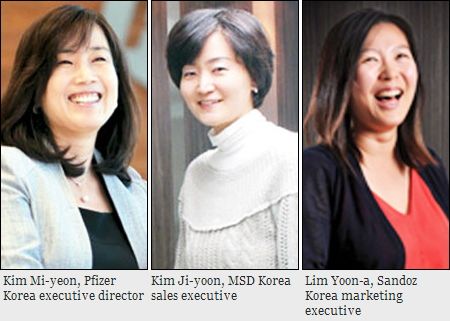
Women rise at foreign drugmakers
The imaginary glass ceiling seems omnipresent for Korean women, who struggle to advance their corporate careers in a country that data shows has the highest level of workplace gender division among rich economies.
For female employees frustrated by the pace of advancement, branches of foreign pharmaceutical companies here may feel like fantasy islands.
In a country where women in their 30s and 40s struggle enormously to hang on to their jobs due to the lack of freedom in work-life balance, female executives are hard to find at most companies.
But foreign drug makers operating here are an exception. Women often outnumber men in executive positions as these companies have been bolder in breaking away from Korea’s macho corporate culture based on long working hours.
Seven of the 13 executive-level seats at MSD Korea are occupied by women. They also account for more than 60 percent of the executive-level employees at Lily Korea and Novartis Korea.
Industry kingpin Pfizer is lower on the list with 40 percent of its executive positions taken by women. Still, it is a much higher proportion than the industry norm in Korea.
“The biggest favor a company can do its female employees is establishing a corporate culture that doesn’t allow any form of discrimination against women,’’ said Hwang Sung-hye, a female executive at Pfizer Korea. “Our personnel management system treats all employees equally and awards them solely on their performance rather than putting too much weight on gender-related intangibles.’’
With Park Geun-hye, daughter of assassinated military strongman Park Chung-hee, voted in as the country’s next president, the issue of gender equality and empowering women at work appears to be moving toward the front burner.
Lawmakers from the governing Saenuri Party have already submitted a bill to the National Assembly mandating state-run companies to give a minimum 30 percent of their executive positions to women within the next five years. Women in senior government positions accounted for 3.7 percent of the total in 2011 and there is expected to be improvement on this front as well.
Progress in the private sector, however, could prove to be slower. The percentage of female executives at the country’s top 100 businesses failed to reach even 1.5 percent in 2011.
The recent personnel reshuffle at Samsung Group, the country’s industrial kingpin, left just 12 executives among a group of 458.
There are only 10 female executives in the country’s third largest conglomerate SK Group. There are less than five at Hyundai Motor and LG Group.
There are only a handful of female chief executive officers among the top Korean companies and half of them are daughters of the parent group’s chairman.
According to business consulting firm Mckinsey & Company which studied 744 listed companies in the 10 biggest economies in Asia last year, the number of female executives at Korean companies stood at 1 percent, behind Japan’s 2 percent and China’s 8 percent.
European companies had 17 percent of their executive seats taken by women, while the proportion for American firms was 15 percent.
A study last year by the Samsung Economic Research Institute (SER) found that less than 1 percent of Korean firms that hire more than 1,000 employees have female CEOs.
Only 17 percent of the companies’ mid-level managers were women, while female executives accounted for just over 6 percent. By comparison, 3.6 percent of the global firms that make Fortune magazine’s Fortune 500 list were led by female CEOs, a six-fold increase from 0.6 percent in 2000. <The Korea Times/Park Si-soo>


